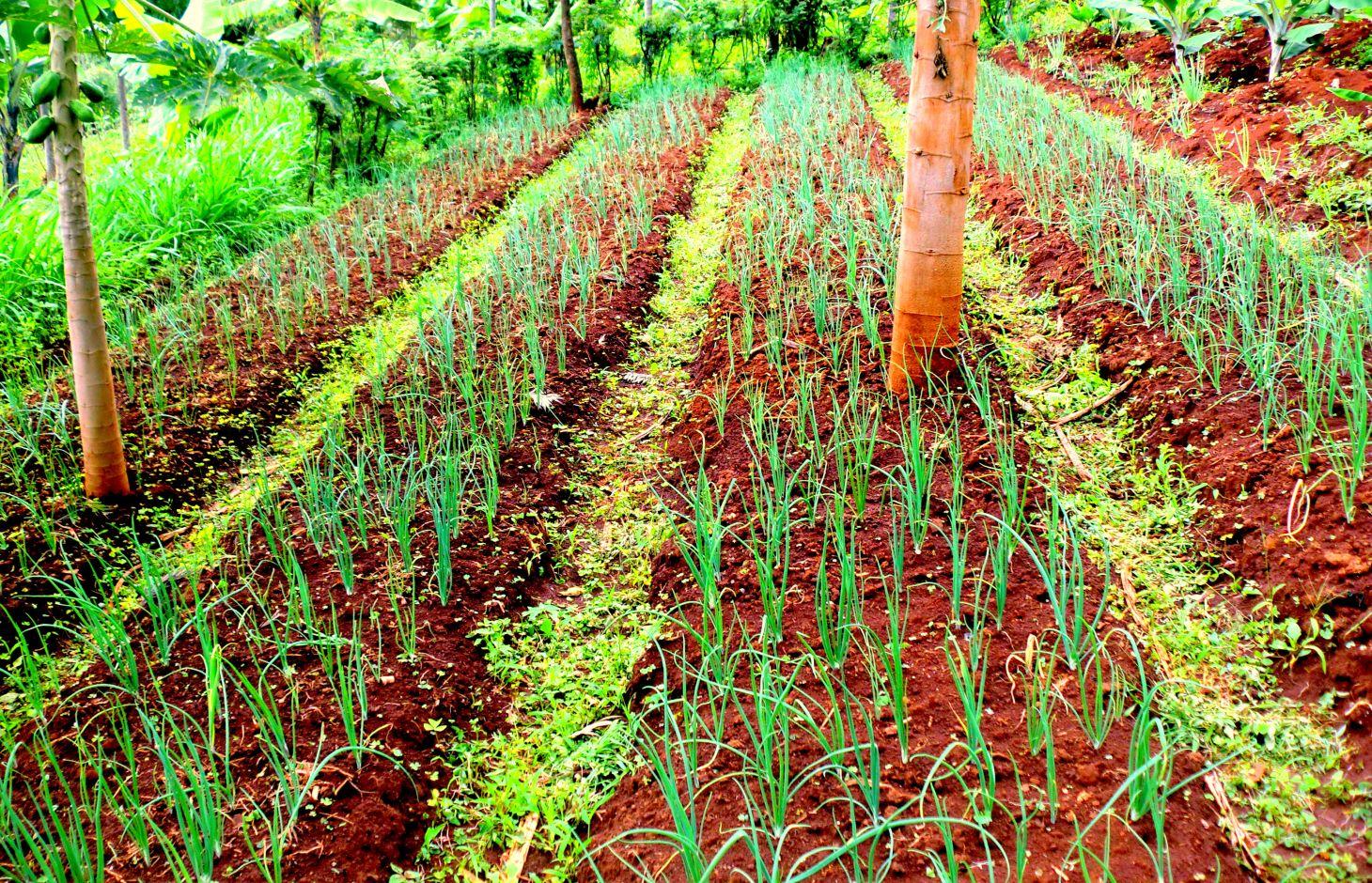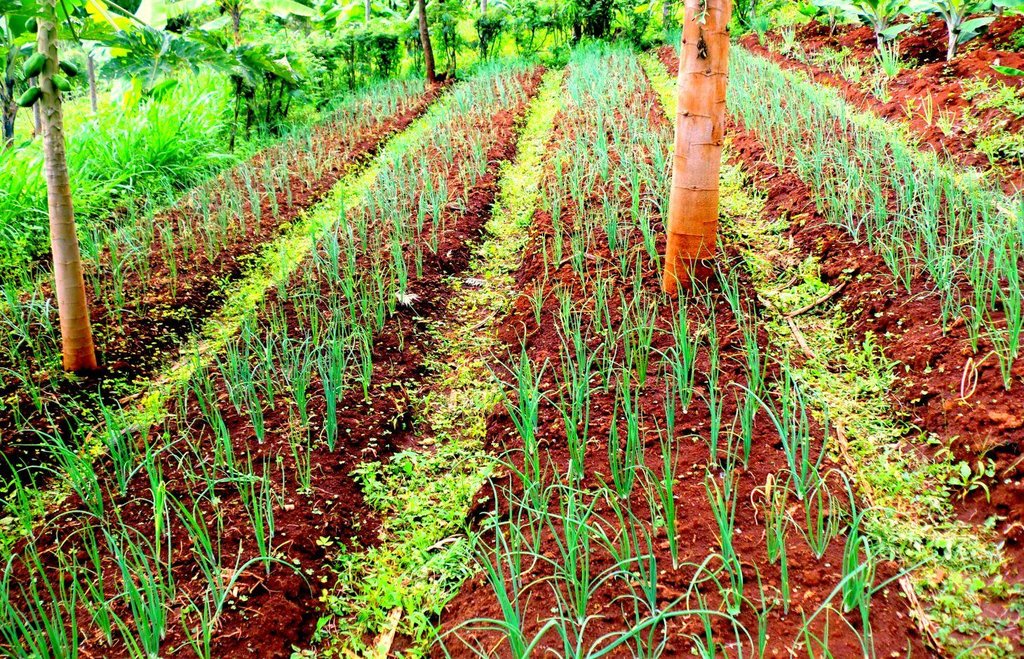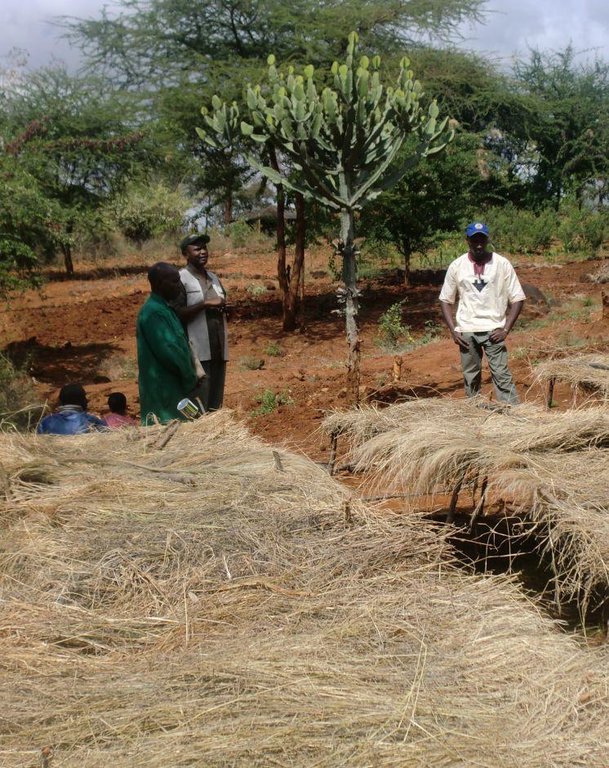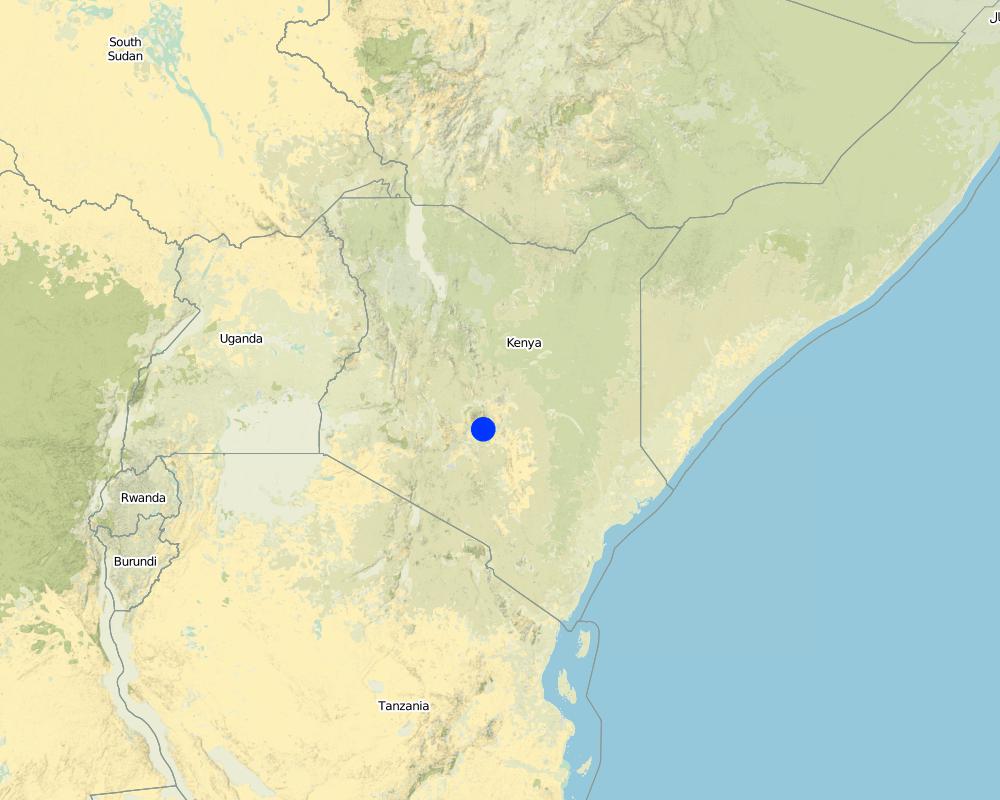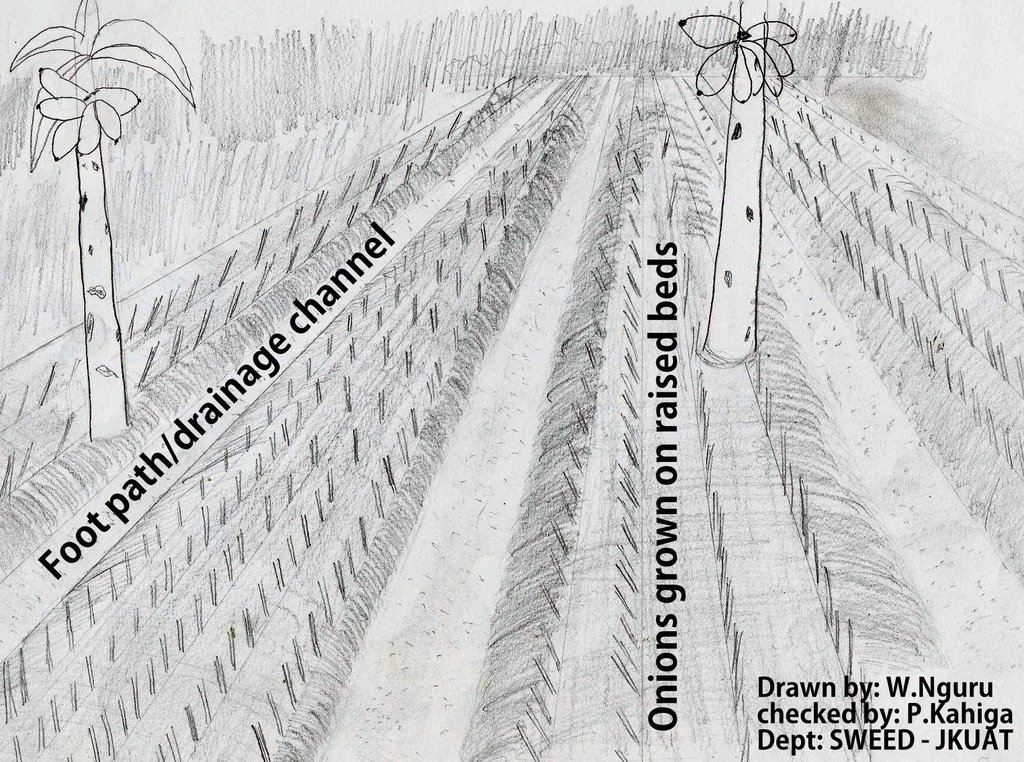Raised Beds for Onions [Kenya]
- Creation:
- Update:
- Compiler: Paul Kahiga
- Editor: –
- Reviewers: Fabian Ottiger, Alexandra Gavilano
Raised Beds for Onions
technologies_1324 - Kenya
View sections
Expand all Collapse all1. General information
1.2 Contact details of resource persons and institutions involved in the assessment and documentation of the Technology
SLM specialist:
Omwange Adamba
Jomo Kenyatta University of Agriculture and Technology
Kenya
SLM specialist:
Kimengich Baobab
Jomo Kenyatta University of Agriculture and Technology
Kenya
SLM specialist:
Chege Timothy
Jomo Kenyatta University of Agriculture and Technology
Kenya
SLM specialist:
Home Patrick
Jomo Kenyatta University of Agriculture and Technology
Kenya
SLM specialist:
Gathenya Mwangi
Jomo Kenyatta University of Agriculture and Technology
Kenya
SLM specialist:
Karanja Andrew
Kenya Agricultural Research Institute
Kenya
SLM specialist:
Wamuongo Jane
Kenya Agricultural Research Institute
Kenya
SLM specialist:
Namirembe Sara
World Agroforestry Centre (ICRAF)
Kenya
Name of the institution(s) which facilitated the documentation/ evaluation of the Technology (if relevant)
International Centre for Research in Agroforestry (ICRAF) - KenyaName of the institution(s) which facilitated the documentation/ evaluation of the Technology (if relevant)
Jomo Kenyatta University (Jomo Kenyatta University) - KenyaName of the institution(s) which facilitated the documentation/ evaluation of the Technology (if relevant)
KARI Headquarters (KARI Headquarters) - Kenya1.3 Conditions regarding the use of data documented through WOCAT
The compiler and key resource person(s) accept the conditions regarding the use of data documented through WOCAT:
Ja
1.4 Declaration on sustainability of the described Technology
Is the Technology described here problematic with regard to land degradation, so that it cannot be declared a sustainable land management technology?
Nee
2. Description of the SLM Technology
2.1 Short description of the Technology
Definition of the Technology:
These are raised beds measuring one meter in width and 15 cm high used for planting onions after transplanting.
2.2 Detailed description of the Technology
Description:
Raised beds are popular among gardeners with limited space or poor naturally occurring soils. Remember that onions are shallow-rooted, but the majority of the roots are intensely located within 8" of the plant. If you were to plant the lines of the bed closer than 8" it would double the competition for nutrients within that area.
Purpose of the Technology: The main purpose of constructing the raised beds for onions is to ease operation as. e.g watering and weeding. To conserve moisture through reduced water losses. To increase yield through increased planting space. Keeps roots away from contaminated soil. Raised beds for onions are good for disabled or elderly gardeners. The beds are neat, they leads to improved soil structure. It also keeps roots from getting waterlogged in a wet climate.
Establishment / maintenance activities and inputs: The land is fist cultivated the soil clod are broken to attain fine tilth. Mulching is done where the beds width is 1m and path of 1ft is done. soil from the foot paths is scooped and placed on the 1m portion to develop raised beds.
Natural / human environment: In Embu county, most of the farmers construct a bed of 1m wide 4” high and a length equal to the land portion on this raised bed, onions are then planted in rows along the assumed contour.
2.3 Photos of the Technology
2.5 Country/ region/ locations where the Technology has been applied and which are covered by this assessment
Country:
Kenya
Region/ State/ Province:
Eastern Province
Further specification of location:
Embu District
Specify the spread of the Technology:
- evenly spread over an area
If precise area is not known, indicate approximate area covered:
- 0.1-1 km2
Comments:
Found at this farmers farm, but from extension officer and this farmer ,other farmers are trying to adopt the technology and others are trying to compare it with the traditional farming system.
Map
×2.7 Introduction of the Technology
Specify how the Technology was introduced:
- through land users' innovation
- through projects/ external interventions
3. Classification of the SLM Technology
3.1 Main purpose(s) of the Technology
- improve production
- create beneficial economic impact
3.2 Current land use type(s) where the Technology is applied

Cropland
- Annual cropping
Annual cropping - Specify crops:
- vegetables - root vegetables (carrots, onions, beet, other)
Number of growing seasons per year:
- 2
Specify:
Longest growing period in days: 60, Second longest growing period in days: 60
Comments:
Major land use problems (compiler’s opinion): soil erosion, poor water infiltration and aeration
Major land use problems (land users’ perception): water logging leading to rotting of onion roots
3.4 Water supply
Water supply for the land on which the Technology is applied:
- mixed rainfed-irrigated
3.5 SLM group to which the Technology belongs
- home gardens
- Raised beds for improved production
3.6 SLM measures comprising the Technology

agronomic measures
- A3: Soil surface treatment

structural measures
- S2: Bunds, banks
Comments:
Type of vegetative measures: aligned: -linear
3.7 Main types of land degradation addressed by the Technology

soil erosion by water
- Wt: loss of topsoil/ surface erosion
Comments:
Main causes of degradation: soil management, poverty / wealth
Secondary causes of degradation: deforestation / removal of natural vegetation (incl. forest fires), Heavy / extreme rainfall (intensity/amounts), labour availability
3.8 Prevention, reduction, or restoration of land degradation
Specify the goal of the Technology with regard to land degradation:
- prevent land degradation
- restore/ rehabilitate severely degraded land
4. Technical specifications, implementation activities, inputs, and costs
4.1 Technical drawing of the Technology
Technical specifications (related to technical drawing):
The technical drawing on the left hand side shows onions planted on raised beds. The beds measure 1 meter in width and the beds are raised 15 CM from the normal surface. there is a foot path in between the beds which doubles as a drainage channel to drain off excess water. It allows planting, weeding and harvesting easy without stepping on the beds.
Location: Embu North District. Eastern province
Technical knowledge required for field staff / advisors: moderate
Technical knowledge required for land users: moderate
Main technical functions: control of concentrated runoff: retain / trap, control of concentrated runoff: drain / divert, reduction of slope angle, increase of infiltration, reduction in wind speed
Secondary technical functions: water harvesting / increase water supply, increase of biomass (quantity)
Agronomic measure: raised beds
Aligned: -linear
Vegetative material: C : perennial crops
Author:
P.Kahiga, 62000-00200 Nairobi
4.3 Establishment activities
| Activity | Timing (season) | |
|---|---|---|
| 1. | Purchase of the seeds | Before planting season |
| 2. | Ploughing | Before planting season |
| 3. | Making of raised beds | |
| 4. | Planting of seedlings |
4.4 Costs and inputs needed for establishment
| Specify input | Unit | Quantity | Costs per Unit | Total costs per input | % of costs borne by land users | |
|---|---|---|---|---|---|---|
| Labour | Ploughing | person days | 1.0 | 4.7 | 4.7 | 100.0 |
| Labour | Making of raised beds | person days | 1.0 | 4.7 | 4.7 | 100.0 |
| Labour | Planting of seedlings | person days | 1.0 | 4.7 | 4.7 | 100.0 |
| Equipment | Animal traction | person days | 1.0 | 5.88 | 5.88 | 100.0 |
| Equipment | Tools | 1.0 | 10.6 | 10.6 | 100.0 | |
| Plant material | Onion seeds | kg | 2.0 | 2.5 | 5.0 | 100.0 |
| Fertilizers and biocides | Fertilizer | 1.0 | 35.3 | 35.3 | 100.0 | |
| Total costs for establishment of the Technology | 70.88 | |||||
| Total costs for establishment of the Technology in USD | 70.88 | |||||
4.5 Maintenance/ recurrent activities
| Activity | Timing/ frequency | |
|---|---|---|
| 1. | Weeding | After planting |
4.6 Costs and inputs needed for maintenance/ recurrent activities (per year)
| Specify input | Unit | Quantity | Costs per Unit | Total costs per input | % of costs borne by land users | |
|---|---|---|---|---|---|---|
| Labour | Weeding | Person days | 1.0 | 4.7 | 4.7 | 100.0 |
| Equipment | Tools for weeding | 1.0 | 5.3 | 5.3 | 100.0 | |
| Fertilizers and biocides | Compost/manure | 1.0 | 3.5 | 3.5 | 100.0 | |
| Total costs for maintenance of the Technology | 13.5 | |||||
| Total costs for maintenance of the Technology in USD | 13.5 | |||||
4.7 Most important factors affecting the costs
Describe the most determinate factors affecting the costs:
Labour is the most determinate factor affecting the costs.
5. Natural and human environment
5.1 Climate
Annual rainfall
- < 250 mm
- 251-500 mm
- 501-750 mm
- 751-1,000 mm
- 1,001-1,500 mm
- 1,501-2,000 mm
- 2,001-3,000 mm
- 3,001-4,000 mm
- > 4,000 mm
Agro-climatic zone
- sub-humid
Thermal climate class: tropics
5.2 Topography
Slopes on average:
- flat (0-2%)
- gentle (3-5%)
- moderate (6-10%)
- rolling (11-15%)
- hilly (16-30%)
- steep (31-60%)
- very steep (>60%)
Landforms:
- plateau/plains
- ridges
- mountain slopes
- hill slopes
- footslopes
- valley floors
Altitudinal zone:
- 0-100 m a.s.l.
- 101-500 m a.s.l.
- 501-1,000 m a.s.l.
- 1,001-1,500 m a.s.l.
- 1,501-2,000 m a.s.l.
- 2,001-2,500 m a.s.l.
- 2,501-3,000 m a.s.l.
- 3,001-4,000 m a.s.l.
- > 4,000 m a.s.l.
5.3 Soils
Soil depth on average:
- very shallow (0-20 cm)
- shallow (21-50 cm)
- moderately deep (51-80 cm)
- deep (81-120 cm)
- very deep (> 120 cm)
Soil texture (topsoil):
- medium (loamy, silty)
Topsoil organic matter:
- medium (1-3%)
If available, attach full soil description or specify the available information, e.g. soil type, soil PH/ acidity, Cation Exchange Capacity, nitrogen, salinity etc.
Soil fertility: High
Soil drainage/infiltration: Good
Soil water storage capacity: Medium
5.4 Water availability and quality
Ground water table:
5-50 m
Availability of surface water:
good
Water quality (untreated):
good drinking water
5.5 Biodiversity
Species diversity:
- medium
5.6 Characteristics of land users applying the Technology
Market orientation of production system:
- mixed (subsistence/ commercial)
Off-farm income:
- less than 10% of all income
Relative level of wealth:
- average
Individuals or groups:
- individual/ household
Level of mechanization:
- manual work
Indicate other relevant characteristics of the land users:
Land users applying the Technology are mainly common / average land users
Population density: 10-50 persons/km2
Annual population growth: 0.5% - 1%
5.7 Average area of land used by land users applying the Technology
- < 0.5 ha
- 0.5-1 ha
- 1-2 ha
- 2-5 ha
- 5-15 ha
- 15-50 ha
- 50-100 ha
- 100-500 ha
- 500-1,000 ha
- 1,000-10,000 ha
- > 10,000 ha
Is this considered small-, medium- or large-scale (referring to local context)?
- small-scale
5.8 Land ownership, land use rights, and water use rights
Land ownership:
- individual, titled
Land use rights:
- individual
Water use rights:
- individual
5.9 Access to services and infrastructure
health:
- poor
- moderate
- good
education:
- poor
- moderate
- good
6. Impacts and concluding statements
6.1 On-site impacts the Technology has shown
Socio-economic impacts
Production
crop production
risk of production failure
land management
Income and costs
farm income
workload
Socio-cultural impacts
SLM/ land degradation knowledge
Improved livelihoods and human well-being
Ecological impacts
Water cycle/ runoff
excess water drainage
6.2 Off-site impacts the Technology has shown
damage on neighbours' fields
6.3 Exposure and sensitivity of the Technology to gradual climate change and climate-related extremes/ disasters (as perceived by land users)
Climate-related extremes (disasters)
Hydrological disasters
| How does the Technology cope with it? | |
|---|---|
| general (river) flood | well |
6.4 Cost-benefit analysis
How do the benefits compare with the establishment costs (from land users’ perspective)?
Short-term returns:
positive
Long-term returns:
positive
How do the benefits compare with the maintenance/ recurrent costs (from land users' perspective)?
Short-term returns:
positive
Long-term returns:
positive
6.5 Adoption of the Technology
Comments:
There is a moderate trend towards spontaneous adoption of the Technology
6.7 Strengths/ advantages/ opportunities of the Technology
| Strengths/ advantages/ opportunities in the compiler’s or other key resource person’s view |
|---|
| Reduce flooding on the fields |
| Increases crop productivity hence more yields |
| Reduces crop prone diseases to onions |
6.8 Weaknesses/ disadvantages/ risks of the Technology and ways of overcoming them
| Weaknesses/ disadvantages/ risks in the compiler’s or other key resource person’s view | How can they be overcome? |
|---|---|
| Its a beat tedious because of raising the soils to form beds | Care should be taken to construct standard beds that can with proper drainage channels to safely evacuate run-off water |
| During heavy storms, they may collapse | |
| May prevent movement of machinery in the farm |
7. References and links
7.1 Methods/ sources of information
- field visits, field surveys
- interviews with land users
When were the data compiled (in the field)?
18/09/2012
Links and modules
Expand all Collapse allLinks
No links
Modules
No modules


